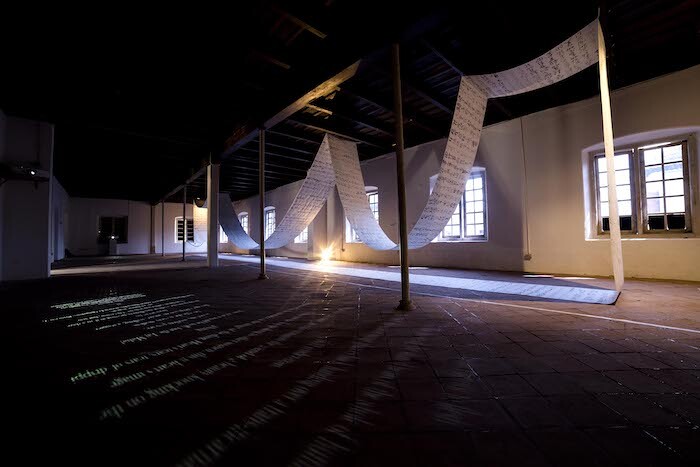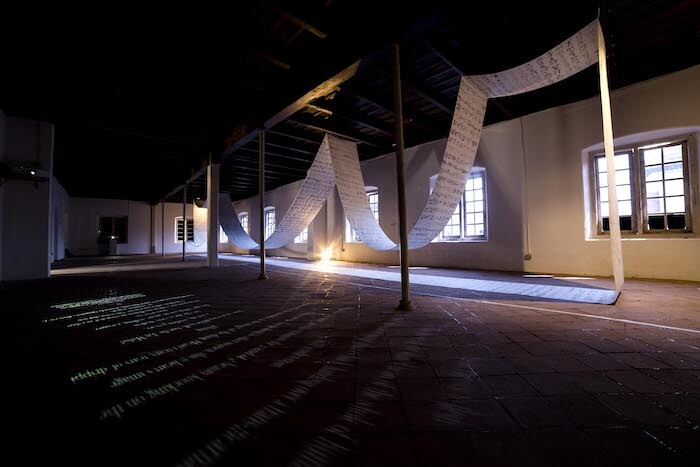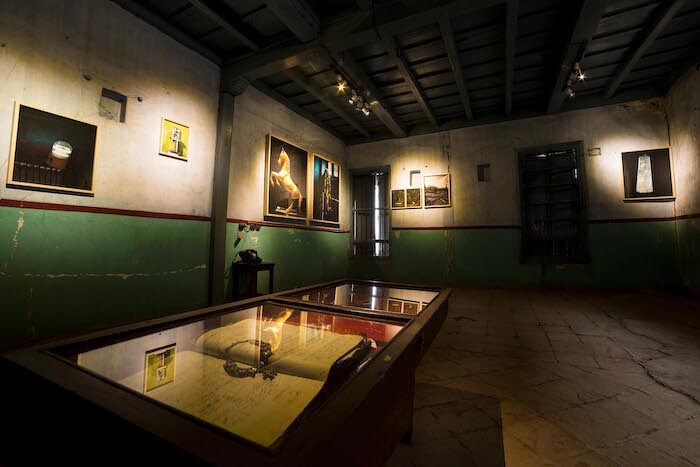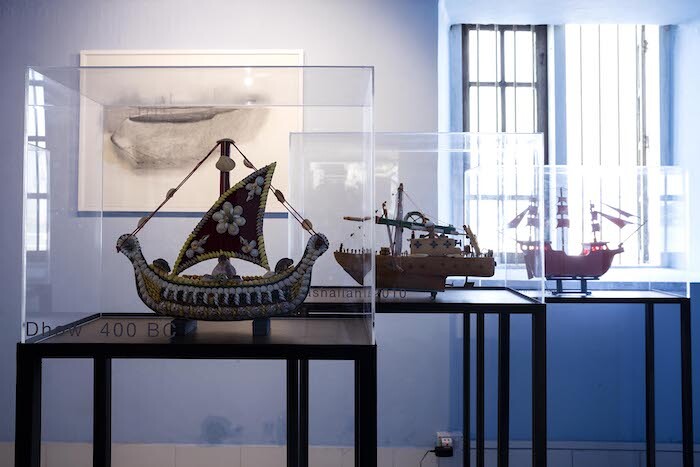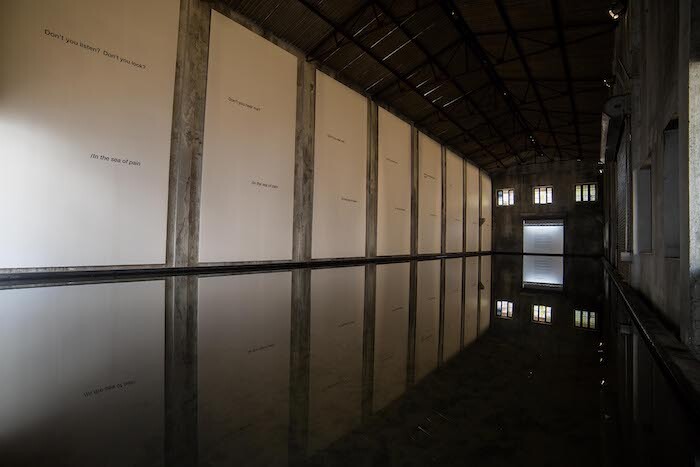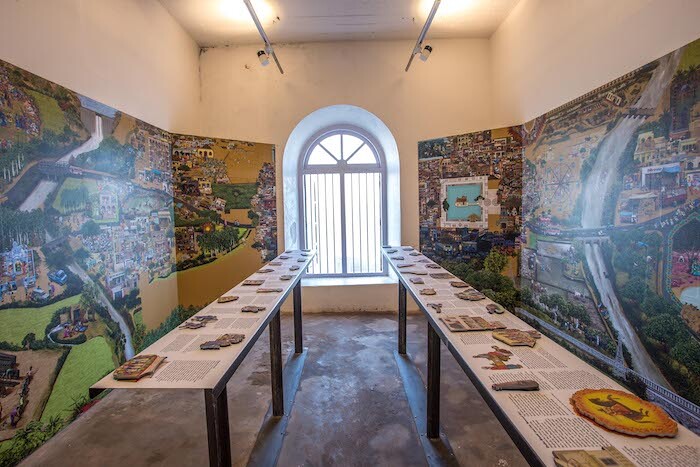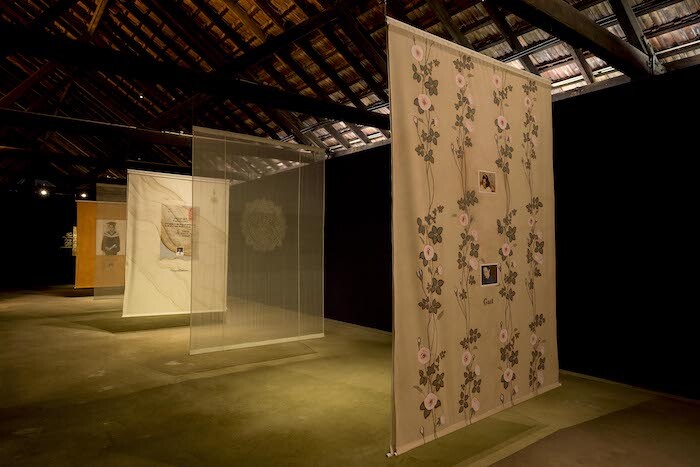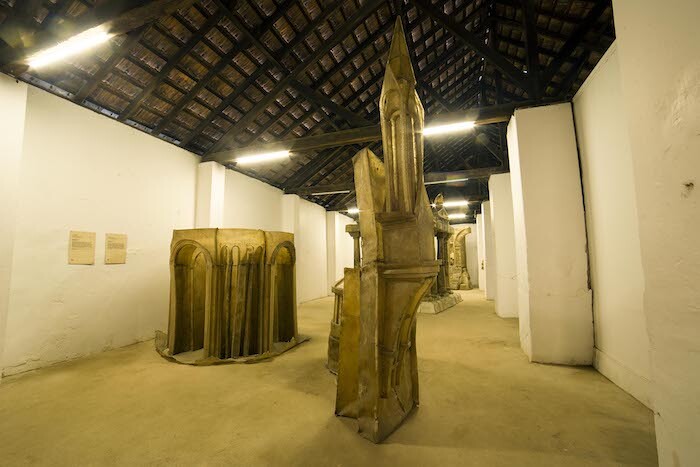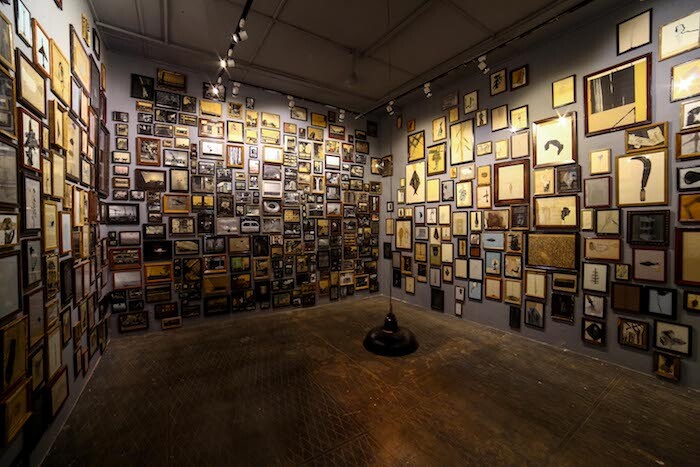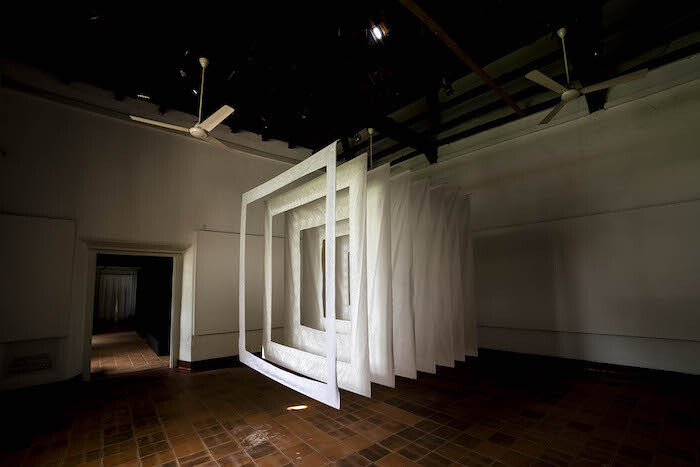Guest curated by artist Sudarshan Shetty, the third edition of the Kochi-Muziris Biennale (KMB), titled “Forming in the pupil of an eye,” is an assembly of artist-created realities. Shetty outlines his curatorial concept with the story of a young traveler who went on a long journey to meet a sage. When he reaches her, “the Sage assimilates the entire universe. In that single moment and one vision, she grasps its enormous multiplicity—internal and external—and reflects those multiple images back onto the boy and back into the space between them both. Through the generation and layering of visions, the Sage creates multiple understandings of the world, speaking those to the young traveller in front of her.”1 Like the sage’s vision, Shetty’s exhibition layers various worldly positions in a single space.
As visitors navigate across the Biennale’s 12 venues in Fort Kochi, they are likely to encounter a number of auto rickshaws proudly displaying a KMB-branded “It’s My Biennale” sticker. Latvian artist Voldemārs Johansons’s intervention, Convocation (2016), also makes use of the city’s autos, replacing the horns of hundreds of local rickshaws with a variety of unusual sounds, including bird songs, whistles, and sirens, which will fill Kochi’s streets for the duration of the Biennale.
As with the previous editions, this year’s principal venue is Aspinwall House. Situated on the banks of the Arabian Sea, the colonial structure brings together an eclectic mixture of works and artists. Keralan artist C Bhagyanath’s Secret Dialogues (2016) consists of an ongoing series of multi-layered pencil drawings on translucent paper. Inspired by the North Keralan ritual of Theyyam, the drawings are pinned in small stacks against white walls, each layer building on what’s underneath to create a sense of movement, as the translucent layers are read together. Dia Mehta Bhupal’s papier-mâché work Bathroom Set (2016) is constructed from thousands of magazine cutouts which the Mumbai artist has meticulously glued together to form a life-size reproduction of a public bathroom (including a tiled floor, a toilet, and urinals). It’s a familiar yet unnervingly fragile scene, not able to withstand use.
Japanese artist Yuko Mohri’s eerie, delicate series of kinetic-sonic installations, “Calls” (2013-2016), tinkle and chime across the white tiled surfaces of Aspinwall House in response to unseen forces of gravity, magnetism, light, and wind. Constructed from a collection of found and reconfigured everyday items and machine parts, the works’ slow and careful movements seem to echo the building’s past life as a laboratory. Also addressing sound, and taking advantage of Aspinwall’s breathtaking view, is Camille Norment’s installation Prime (2016), whose wooden benches face the estuary and vibrate with the sound of moaning, akin to that of someone deep in meditation.
Another highlight at Aspinwall is Sangam Dialogue (2016), by artist and environmentalist Ravi Agarwal. This installation—combining audio, video, and photography—greets visitors with a video documenting moving, first-hand stories about the colonization of nature. On the far side of the room, a small wooden structure encourages viewers to enter, sit, and contemplate their natural surroundings in isolation through a small round window overlooking the estuary, occasionally interrupted by the passing of a fishing trawler or cargo ship.
One of the most talked-about artworks during the opening of this edition was Sea of Pain (2016), an immersive installation by Chilean poet Raúl Zurita, the simplicity of which read, for some, as gimmicky, while others praised its dexterous handling of potent subject matter. Constructed within one of Aspinwall’s larger warehouse structures, Zurita has created a large seawater pool, inviting visitors to take their shoes off and wade through, after which a poem printed on a far wall becomes legible in its entirety. Dedicated to the brother of Syrian refugee Alan Kurdi, the work invites visitors to consider the complexities of other human lives far removed from their own.
A short walk away is David Hall, where Padmini Chettur’s live performance Varnam (2016) took place during the opening days of the biennale. Drawing on the movements of Bharatanatyam, a genre of traditional Indian dance in which Chettur is trained, a row of five female dancers in unassuming dress were seated on wooden chairs. Moving in harmony, for three hours their carefully choreographed movements echoed Chettur’s concern at the loss of respect for tradition within the Indian contemporary dance Padmini Chetturty and the Bharatanatyam community’s growing isolation.
Also close by, the former Dutch colonial house that hosts Kashi Art Gallery exhibits Abir Karmakar’s photorealistic painted installation Home (2016). One wall of each small gallery space has been fully covered with an oil canvas depicting a typical Indian family’s domestic environment, transforming the gallery space into a set on which their lives could be acted out.
The KMB’s initiatives consist of much more than just the biennial exhibition, including a year-round international artist residency program at Pepper House, which introduces a selection of international contemporary artists to India. During Hanna Tuulikki’s residency, the artist learned the Nadi Varnana [River Description], an expressive form of Sanskrit theater practiced in Kerala, from local practitioner Kapila Venu. She reimagines the traditional sequence to create Sourcemouth: Liquidbody (2016), which is part of the biennale. A collaborative dialogue between the traditional and the contemporary, three separate screens envelop the visitor as the interlinking films play in sequence. The videos show Tuulikki’s figure, fully clad in silver clothing and body paint, carefully interpreting the river description. This is succeeded by a screen which focuses on the dramatic movements of her eyes, and closes with her unbodied lips silently mouthing the dance’s instructions.
Building on its reputation as the people’s biennale2, with its third edition KMB has furthered its efforts to broaden public understanding and access to art across India, expanding its ongoing initiatives to engage multiple groups of students, including Art By Children (ABC) and the Students’ Biennale, which both look to evolve arts education in India. ABC has traveled to over a hundred schools in Kerala conducting workshops, and a selection of the childrens’ work is on display at Aspinwall. The Students’ Biennale connects with state-funded art colleges, making use of the KMB’s global platform to exhibit selected students’ work in parallel to the biennale’s main offerings. This edition shows work by students from 55 art schools across India, curated by 15 young curators.
Moving from venue to venue, it is difficult to understand what weaves all of these many different artists’ works together. Shetty’s curatorial concept is baggy enough to accommodate any artists’ work, which is perhaps why the biennale feels more like a mood board than a cohesive curatorial concept, a reminder that Shetty is by trade an artist and not a curator. This edition of KMB maintains its artist-led approach, entrusting visitors to explore art for themselves and to get lost in a multiplicity of ideas.
Sudarshan Shetty’s curatorial statement, distributed by the biennial’s press team.
As per Sudarshan Shetty, quoted on the KMB website: http://www.kochimuzirisbiennale.org/curator/.
